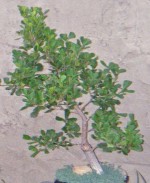 This native of central and west Africa is a medium-sized evergreen plant that is especially good for bonsai. The thick, dark green leaves are small and triangular. They resemble those of boxwood, hence the common and specific (bux-box, folia-leaf) names. The trunk is dark brown with thin and flexible branches that produce a naturally beautiful branching pattern. Flowers are produced in the axils of the leaves and are followed by small, inedible green fruits that are only 3/8” long and rarely ripen.
This native of central and west Africa is a medium-sized evergreen plant that is especially good for bonsai. The thick, dark green leaves are small and triangular. They resemble those of boxwood, hence the common and specific (bux-box, folia-leaf) names. The trunk is dark brown with thin and flexible branches that produce a naturally beautiful branching pattern. Flowers are produced in the axils of the leaves and are followed by small, inedible green fruits that are only 3/8” long and rarely ripen.
 Position: Boxwood Fig is tolerant of indoor conditions so can be grown year around on a brightly lighted windowsill. It likes warm temperature, 65-75o F., and can even be placed directly over a radiator. Once temperatures in the spring are 60o F. or above, boxwood fig can be taken outdoors and placed in a sunny or partially shaded location. In fall when temperatures fall below 60o F., it must be brought in doors again.
Position: Boxwood Fig is tolerant of indoor conditions so can be grown year around on a brightly lighted windowsill. It likes warm temperature, 65-75o F., and can even be placed directly over a radiator. Once temperatures in the spring are 60o F. or above, boxwood fig can be taken outdoors and placed in a sunny or partially shaded location. In fall when temperatures fall below 60o F., it must be brought in doors again.
 Water: Allow the soil to dry out between watering. If the soil is too moist the plant will drop its leaves.
Water: Allow the soil to dry out between watering. If the soil is too moist the plant will drop its leaves.
 Fertilizer: Apply a balanced fertilizer every two weeks from spring and summer, every 6 weeks the rest of the year.
Fertilizer: Apply a balanced fertilizer every two weeks from spring and summer, every 6 weeks the rest of the year.
 Repotting: Repot every two years in mid spring. Prune roots at the same time if necessary.
Repotting: Repot every two years in mid spring. Prune roots at the same time if necessary.
 Soil: Use a soil mix made up of equal parts of loam, peat moss, and sand.
Soil: Use a soil mix made up of equal parts of loam, peat moss, and sand.
 Pruning: Prune branches throughout the year once the new shoots have developed 10-12 leaves leaving the first 2-3 leaves. Getting the trunk and main branches to thicken can be difficult, so allow the main branches to develop 30-40 leaves before cutting back.
Pruning: Prune branches throughout the year once the new shoots have developed 10-12 leaves leaving the first 2-3 leaves. Getting the trunk and main branches to thicken can be difficult, so allow the main branches to develop 30-40 leaves before cutting back.
 Wiring: Plants should be wired during the period of active growth but any time during the year is acceptable. If a formal upright tree is desired, begin when the plant is young.
Wiring: Plants should be wired during the period of active growth but any time during the year is acceptable. If a formal upright tree is desired, begin when the plant is young.
 Propagation: Cuttings during the summer.
Propagation: Cuttings during the summer.
